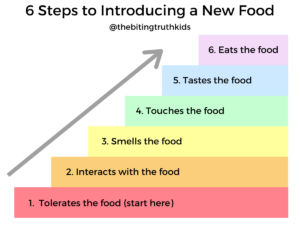6 Steps to Introducing Your Child to a New Food


Have you read our article on The Key to Stress-Free Family Mealtimes? If not, we recommend reading up on that piece before delving into this one.
If you’ve read it, and feel you have The Golden Rules down pat, but your child still only eats a handful of foods, then read on!
Firstly, please remember you are not alone. It is very common and entirely normal for kids under two years to dislike certain foods, often vegetables and meat. Hopefully, from 2-3 years of age you’ll start to see some signs that your child may be more open to trying new foods.
If your child’s eating habits aren’t improving, despite following The Golden Rules – remember you choose WHAT, WHEN & WHERE and they choose IF & HOW MUCH – let’s look at what you can do to help your child build confidence when it comes to trying new foods.
The 6-step approach to introducing a new food
Eating food is complex – in fact, it’s said to be one of the most complex physical tasks that humans engage in. As adults, we happily pick up a food and eat it without much thought, whereas children must overcome all sorts of new sensory experiences before learning to enjoy foods.
Dr. Kay Toomey developed the SOS Approach to feeding, designed to assess and address all the factors involved in feeding difficulties. The approach recognizes there are actually six steps involved with eating, and that eating does not begin in the child’s mouth. All their senses play a part in how they interact with food.
What are the benefits of this approach?
The 6 step approach is an effective way to help children eat a greater variety of foods and increase their confidence in trying new foods by familiarizing each of their senses with the food in question.
It can help remove some of the stress associated with mealtimes and instead make them a pleasant experience for everyone involved.
Who is this approach for?
The 6-step approach is particularly relevant to children who:
- Tolerate a restricted range of foods
- Eat a different meal from the rest of the family
- Are below a healthy weight, or at risk of becoming so due to limited food intake
- Find mealtimes distressing
- Are highly sensitive to the sensory properties of food (smell, taste, texture, sight or sound)
Step 1. Child tolerates the sight of the food
This step is all about getting your child comfortable being in the same room or at the same table as the food you are introducing.
Examples of how you might do this include:
- Putting the food in the shopping trolley with your child present
- Preparing the food in front of your child
- Having the food on the kitchen bench
- Serving it to others at mealtimes
- Serving food at the table
Step 2. Child interacts with the food

Once your child is comfortable looking at the food, encourage them to interact with the food in some way, without directly touching it yet.
This might look like:
- Assisting in the preparation of the food
- Stirring the food using a spoon
- Having your child serve the food to others at the table
- Touching the food with a napkin
- Helping to pack leftovers away
Step 3. Child tolerates the smell of the food
Some children are as sensitive to the smell of certain foods as one would be to a ripe cheese or durian fruit. By exposing your child to the smell of a food in stages – first in the room, then at the table, and lastly directly in front of them – they can learn to tolerate it. Eventually they’ll likely lean down or pick up the food to smell it.
Step 4. Child directly touches the food

Once a child is able to tolerate the sight and smell of a food, the next step is directly touching the food with a body part (e.g., fingers, hands, face).
For example, your child might help:
- Unload the shopping bags and put the food away
- Wash the food
- Peel the food
- Chop the food
Step 5. Child tastes the food

Having a taste of the food may mean simply touching the food to their lips, licking the food, or taking a very small bite and spitting it out.
This is a win! It’s part of the normal developmental process of learning to eat. Next, they may even chew the food before spitting it out! It’s very important there isn’t pressure on the child to eat the food. They need to feel confident they can safely spit the food out if they don’t like it.
Step 6. Child eats the food
The final step is about actually chewing and swallowing the food, aka eating the food! This might happen in a stepwise manner:
- Chews and partially swallows
- Chews and swallows with a drink
- Chews and swallows independently
Again, it’s important to remove any stress or anxiety that may accompany this step by allowing your child to progress at their own pace.
When introducing a new food to a picky eater it’s important you don’t jump directly to this step, for example using the “just take one bite/lick” strategy.
Slow and steady wins the race
These 6 steps are about getting your child comfortable with a new food before you even suggest eating the food. Move through the steps at a pace that works for your child and is tailored to them. If they don’t follow you up the steps, it means you’ve jumped too far. Just back up to a lower step, or sub-step.
Enjoy more tips and tricks from our in-house Dietitians Anna and Alex – Step By Step Guide To Introducing Allergen Foods.
Only About Children can help your child to grow, make friends and explore the world.
Only About Children can help your child to grow, make friends and explore the world.
Related Reads


Talking To Young Children After Traumatic Events
Discussing traumatic events with children is crucial for helping them understand and accept what's happening in their world.

MasterChef Tommy Pham's Coconut Turmeric Chicken With Rice & Greens
MasterChef Tommy Pham has teamed up with our Dietitians Anna & Alex to create a delicious and nutritious lunch option for children to enjoy in campus - Tommy's Coconut Turmeric Chicken/Chickpea with Rice & Greens. Campus cooks will be preparing Tommy's lunch recipe as part of our delicious, rotating Autumn Menu in campuses. Sound delish? Try the recipe at home!

